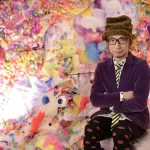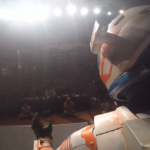(Transcript of original audio interview we recorded at Anime Weekend Atlanta 2010 that aired on the Tokyo Tower Show that same year.)
Zippy: We get the pleasure now to speak to the lovely Helen McCarthy, who is gracing us with her presence. [She’s] been pretty busy at the convention so far. You’ve been to AWA a couple times before. How are you enjoying it so far?
Helen: I’m really enjoying it. One of the nice things about AWA is it’s such a laid back convention. That’s partly because of the hotel, because there’s lots of space. You can circulate. You can see everybody. The atrium and the lobby are always filled with amazing cosplayers. I’ve just come out of my panel, and there’s a Steampunk panel following us and the line for that panel just had the most phenomenal costumes. You know, really amazing. So how could you not have fun?
Zippy: Certainly. Steampunk, anime, all the things going on here…it’s pretty awesome. I think it’s important to note that while many of the voice actors have been in the industry for awhile, you’ve really been a big part of the industry. You’ve set the tone through your books, your writing, and you’ve done so much. If you could mention a few highlights of what you have done in your time.
Helen: Wow. One of the wonderful things about working with anime, and manga, and Japanese popular culture is that there are no downsides. I mean everything is a highlight, so it’s sort of difficult. I’ve been studying anime and manga since 1981. I wrote my first professional articles about it in 1984. I wrote my first book in 1993. So it took awhile to get to a stage I wanted to be at. I started out just wanting to write books about anime, because I couldn’t find any books about anime to read, and I thought ‘This is crazy. There’s nothing available in English’ At the time there was nothing in French which I also read, and Fred Schodt hadn’t even written “Manga Manga” so there was very little in America. I wanted to do a book but everybody told me this Japanese animation stuff is just too way out. Nobody knows anything about it. Nobody would be interested. It took me thirteen years to persuade a publisher to do a book. In order to get there I had to setup my own magazine Anime UK which I still remember with great pride and people still occasionally ask me to sign. We ran in England for five years. We sold in Japan. We were regularly sold in major Japanese bookstores, and we were quite influential. The magazine helped to start the career of a number of writers and designers including people like Jonathan Clements, people like James Swallow who writes gaming tie-in novels, people like Peter J. Evans who does hardcore science fiction, Tara Tag one of the major shirt and graphic designers in Britain who’s worked with the Sunrise team on designs for Gundam. Lots of people got their start in the magazine and I’m really proud of that. And when I look at that my first book seems quite little now. It was a huge project to me when I was doing it, but it was sixty-four pages, kind of what you call a mook now, a magazine size, and the total word count was about half what the index of my most recent book is. So I think it’s fair to say that the industry’s come a long way, and I’m glad to have been able to go with it.
Zippy: Well definitely thank you for writing those books because you talk about how there’s a lack of reference material before, well now of course half of those books seem to be yours so we certainly thank you for that.
Helen: Well thank you. It’s true and I appreciate you saying that, and I have been able to write quite a lot. Of course, what’s happened in the last decade which has been really influential is that the internet and fast broadband in particular has become available to so many people in Europe, America, Britain, and Japan. It’s now very very easy to post information on anime [and] to research information on anime. The hard thing of course is to know whether the person whose post you’re reading is a great authority like Frederick Schodt or Matt Thorn, or a nine-year old kid in a bedroom in Minnesota who’s decided that he’s going to do his own anime blog because he thinks Naruto is really cool. So the difficulty with the internet is that it conceals a great deal about writers, and you just have to be able to judge the information on its own merit. But I love writing in the internet age because it’s so immediate and it’s so easy, and there is so much access to information. The writer’s still responsible for sifting the information, deciding on its credibility, and deciding on how to present it to the reader, but there are just so many more options for writers nowadays. The only downside of course is piracy.
Zippy: I know you’ve spoken out on that, and I believe you use Creative Commons now for much of your material?
Helen: I use Creative Commons for all the material on my blog. I have to be quite careful about the material that I contract with publishers and magazines for because obviously they have rights in that and I can’t just give that away. But I decided awhile back that I think Creative Commons is a wonderful tool for writers because it enables any creators. It enables you to specify what rights in your work you’re willing to share and to make it really simple for anybody to know exactly where they stand, and I think my love for Creative Commons actually dates back to an incident with Anime UK. My partner Steve Kaite was one of our artists. We had a lot of very good artists, and one year for our Christmas issue he did a beautiful little black and white line drawing of our mascot characters bowing beside a Christmas tree. It was really sweet; it was very pretty, and everybody loved it. Readers told us they liked it. The following year we got a Christmas card with it on, and we…the guy was one of our regular readers so we contacted him and he wasn’t somebody ignorant. He was a guy who was in his mid-30’s, worked in a fairly high level industry, but he just didn’t know about copyright. So I rang him and I said ‘you know you really shouldn’t be doing this without Steve’s permission’, and he was so upset and so apologetic. He said ‘I just assumed that anything in the magazine I could use as long as I wasn’t making money.’ Many people make that mistake and that’s why it’s so easy for people to become involuntary pirates as it were.
So the thing with Creative Commons is that when you see a Creative Commons license it’s really easy for you to click through to their website or to the writer’s website and find out exactly what you can and can’t do so you’re 100% safe. And for the writer Creative Commons means that you’re able to say ‘I’m happy for you to be able to do this with my work but if you want to do anything else you have to talk to me’ There’s clarity. Everybody knows where they stand. So all the material on my blog is CC3 non-attributable license, which means essentially you have to credit me and you have to reproduce in full and if you want to amend that then you have to contact me. But as it stands anyone can take any material off my blog and use it under those conditions, because it just seemed like the right way to go. I have recently actually had a request from somebody that wanted to use pages from The Anime Encyclopedia, which is a book I co-wrote a few years ago, in a column that he’s writing for a respected web journal. And I went back to him and said ‘look I’m sorry, we have licensed these rights to a publisher so you’re going to have to go back to the publisher and talk to them, but you can use anything on my blog on Creative Commons’. So that meant that instead of just sending the guy away with nothing I was able to say ‘I can’t give you what you want, but here’s what I can give you and here’s an avenue to explore what you want’ and that feels good. That’s nice.
Zippy: Certainly with the internet and information you come across so many different copyright laws now. I know Britain’s is different from the US and other countries, so Creative Commons sounds like a smart move.
Helen: Well I think the general principle of copyright though should always be that however much you love it, if you didn’t make it you didn’t own it. Especially when it comes to writers in Japan. Quite a number of writers in Japan, the creator of Black Butler [and] many many other manga creators, have come out recently and said that piracy is robbing them. Piracy is taking away their income, and piracy is taking away their right to say how their stuff is used. And to an artist that’s really important you know. Creative artists only have the work they make to bring in income. They don’t get paid by the publishers unless they bring in work, so I think that the wonderful thing with Creative Commons is everyone can be completely sure of what they’re getting, whereas if you simply take an artist’s work and reproduce it, you know, on your t-shirt, or your stationary, or your website or whatever, you are actually stealing from that artist. If you love somebody you don’t steal their stuff. That’s just not what you do.
Zippy: I certainly understand that. Nick here works in a bookstore, so he sees both the piracy of the written word and actual books all too often sadly. Nick did you have any specific questions that you wanted to pose to her?
Nick: I definitely want to talk about this cross-stitching book that you made, because it kind of stands out from your others. You did a lot of those designs yourself I saw?
Helen: I did.
Nick: What was it like putting that book together?
Helen: That was the most awesome experience. Generally speaking I find that when somebody says to me ‘this is impossible it can’t be done’ I say ‘oh yeah, oh yeah’ and I go ahead and do it, and that’s what I did with my first book when people said there’s no demand for a book on Japanese animation, and I thought ‘right let’s create one’. And with Manga Cross-stitch…I’ve been cross-stitching since I was four years old. My grandmother taught me. And I’ve been doing my own designs for about ten years on the Mac, and I really enjoyed them and I started to think about doing anime and manga designs and it just suddenly seemed to be so rationale. I looked at the other designs on the net and every single other design I found was either pirated direct from an anime or manga pattern panel or using a licensed character, and I even found people selling designs of licensed characters which is just so not fair. So I thought ok why are people doing this? Number one they love these characters. Ok nothing I can do about that. The character owners have to license them for stitching. Number two they love anime and manga and they love certain types of characters like robots or ninjas, but they don’t know how to design their own. So I thought ‘ok let’s think about making a book that takes you step by step through the design process and shows you all the different tropes, the visual grammar, of anime and manga that you can use to make your own designs; let’s give people a toolkit that will equip them to make their own anime and manga designs in stitching,’ and luckily my partner Steve, [who] was one of our Anime UK artists, is a wonderful artist, and he agreed to help me out and give me some designs. So between us the two of us created every design in the book, and again we’ve licensed those designs for private use to anybody who stitches. I’ve actually gone on my stitch blog and said to people that if there are charity stitchers out there who want to stitch them for sale for charity all they’ve got to do is get in touch with us and we’ll sort something out. But the fun of doing that was in taking…cause if you think about anime and manga, even very simple manga styles, they’re all curved. Even a speed line is generally curved somewhere. There’s so much dynamism. When you’re working in counted cross stitch or any counted thread embroidery you’re working on a 45 degree angle grid at all times, so the challenge there was to find a way of putting that dynamism in, and the other challenge that I really wanted to tackle was making it fun for beginners.
One of the things that’s really pleased me is a lot of very authoritative stitch blogs and stitch critics have said that the instructions in the book are so clear, and so simple, and that they’re easy for beginners to follow and that’s great. But you know when you’re beginning a craft or beginning an art you get projects and the projects are always really simple, really little, really basic things. Most people when they start cross stitch get given a little flower or a blocky teddy bear, and I thought ‘I want guys to do this; I want robot fans to do this‘. So the book focuses mainly on designs that only use whole cross stitches, which is the simplest stitch to do, and you can stitch them very fast and you can stitch them very easily, but there are some big, challenging, complicated looking zappy designs in there, which still only use the basic technique of whole cross stitch. So you don’t need to be technically a brilliant stitcher to create a big stunning picture, and the biggest piece in the book, which I’m working on at the moment, is a thirty-two inch tall, virtually door panel size, samurai girl fighter in lacquered armor and she’s just…she has two little bits of back stitching defining her eyelids [and] the rest is whole stitch, so a complete beginner could make her. I mean she’s big so it would take time, but a complete beginner could make her. We have a scene with two massive giant robots stomping through a destroyed city street with sound effects on top, which again all basic cross stitchers, a complete beginner, could take that on. It’s a big project. It would take several months, but that could be your first project. So instead of having to say ‘hey this is my first project I stitched this little flower’ [you could say] ‘hey this is my first project. I stitched this twenty-eight inch by twenty-eight inch picture of two giant robots destroying a city’. That’s a good start. That’s a good opening.
Nick: Along that line, you like to design. You like the cosplay you’ve seen here. Have you ever made a cosplay for yourself?
Helen: Oh have I ever made a cosplay for myself. I actually started out in fandom in cosplay. Not in anime fandom but science fiction fandom over thirty years ago. I’ve been a costume maker since I was about six year…actually my mother said I’ve been a costume maker since I was three. She kept a pathetic little tangle of scraps of leftover thread that she said were a Tudor costume that I had made for one of my dolls when I was three-years old. I remember making my first costume for myself and my little sister from crepe paper for a school Christmas party, you know with glue, at the age of six. And they held together. They lasted the party. They did what costumes are supposed to do. And then I just got really interested in costume and the history of costume and character costume, and when I was a teenager I made costume for school plays. When I was in college I made costume for college plays, and then when I moved to London and joined science fiction fandom I began to make costumes for science fiction conventions. Back then certainly in Britain, and I think in the States to an extent, costume was in a fairly primitive state and not many girls went to science fiction conventions, so I was one of about four women regularly showing up and making costume. Boy did you get bought a lot of drinks that way. It was pretty good. And I went on from there and have always loved costume.
I haven’t done anime cosplay for many many years, but I still occasionally when I get time do historical cosplay. I do historical recreation, and again there the challenge for me is recreating a historical costume using historical methods and getting as close as I can to my source material, which is usually a portrait. But I also make costume for dolls, and they’re wonderful because they never bitch about the color, they never bitch about the fit, they never gain weight, they never complain that this doesn’t go with their hair. Dolls are just very easy so…and also of course the problem with coming to conventions in the States is that if you want to carry cosplay it takes some packing. I mean you’ve seen some of these people here; they need vans. I’ve seen people who need trucks to move their costumes for some of the robot armor, so that would take some thinking about but…yeah it’s just great to see cosplay and I’m really happy to have been part of it, and I would love to do some cosplay at an anime con. So maybe one day. Maybe one day who knows.
Zippy: If you don’t mind I want to return to talking about your writing. What book do you think should be made that hasn’t been made yet, or maybe it’s been made by someone else, but that you would really love to take on that you just kind of think is needed?
Helen: Well it’s odd you should say that because I wrote a book last year called The Art of Osamu Tezuka: God of Manga for Abrams, and one of the books that I pitched the same time I pitched it was a book on the Japanese street art Kamishibai. Kamishibai is a kind of paper theatre where people tell stories accompanied by illustration. And I really wanted to do a book about it. I was very enthusiastic about it when I found it because it’s both performance and narration, and my pitch was turned down; and I was actually told by my British publisher ‘We can’t sell this in the States. I don’t know why because I think it’s great, but we’ll never sell enough copies in the U.K. to cover production costs of a big full color book so we can’t do it’. I later found out that the reason that we couldn’t sell it in the U.S. is that Abrams had already bought a Kamishibai book Manga Kamishibai by Eric P. Nash, which is a fabulous book. I mean I would’ve really loved to write about Kamishibai, and maybe one day I will but I don’t think I could’ve done it better than Eric’s done it. I would’ve done it differently, but I don’t think I could’ve done it better because that is a fantastic book.
The book that I want to write next is…well there are two books that I really want to write and I have…the publishing industry is difficult at the moment. It’s very difficult to sell a niche title, and in Britain we can’t make full color books anymore without an American co-edition because we can’t get the numbers to cover the print costs, but I would really like to make a book on Shigeru Mizuki. I think he is just such a fascinating guy. Not only is he the only one-armed manga artist I know of, not only is he a passionate anti-war campaigner, and a survivor of World War II and the two obviously go together, not only is he a great mangaka and a great storyteller, but he’s also an international authority on Japanese folk lore. And every day, he’s in his mid-eighties, he still gets up every morning and does a full day’s work. This guy is a phenomenon, and I would love to do a book about him.
And the other thing I’d like to do, studying Tezuka, I got really interested in his influences and his antecedents. Now that whole area of pre-war early twentieth century manga history is almost completely unexplored in English or in French, and if you look at the great books about manga, Schodt covers it very briefly in Manga! Manga! The World of Japanese Comics, but there he had a very limited brief for the book; he had a lot to cover. Gravett in Manga: 60 Years of Japanese Comics glances at it. Brigitte Koyama-Richard in A Thousand Years of Manga glances at it. There is so much in there, and I’d always assumed like a lot of people that these authorities glanced at it because there wasn’t much material available. My Japanese is pidgey. I cannot speak Japanese. If I start speaking Japanese to people they start speaking English or French to me; that’s how bad I am. They know that I can’t speak Japanese. But with patience, and a good dictionary, and a good search engine anybody can basically translate Japanese if they’ve got the time. So I took a couple people at random, and that was where my “Unknown in English” column on the blog came from, going in and finding writers, some of them contemporary, some of them old, and finding how much material there is out there. It just isn’t in English. Just before I came here I published on the blog my work on…my initial research notes on Ippei Okamoto. Now Ippei Okamoto founded the first manga cartoonist trade union in 1915. He was a protégé of the great Natsume Sōseki, the Japanese writer. He worked on Asahi Shimbun as a journalist cartoonist from 1911 to the end of the 30s, and his son Tarō Okamoto is one of the great avante garde artists of twentieth century Japan. There is a lot of material on Okamoto, but all I was reading, even on one of my favorite comics sites Lambiek.Net http://www.lambiek.net, which is a Belgian site that collects information on comic artists all over the world, even they only had like two paragraphs and half a dozen titles mentioned. Do you know how long it took me to get a complete Okamoto timeline and a lot of titles to fill in there, not all of them, but a lot?
Zippy: I’m impressed by you, so I’m going to assume not as long.
Helen: It took me four days. This is a guy that nobody has bothered to write-up and yet he is one of the two founding fathers of manga with Rakuten Kitazawa, and it took me with virtually no Japanese four days to find his career.
Zippy: That’s impressive.
Helen: And it’s not, because it’s sad; because anyone could do that! But people have been blogging about Okamoto, and listing Okamoto, and writing on their sites about Okamoto, and nobody has bothered. So I say to myself ‘is this because I’m really dumb and everyone who is interested can read in Japanese or is it just that we have so much history out there and people just need nudging in the right direction?’ I hope it’s that. Because I had a lot of fun, and I’ve put together all the material I found on Okamoto so far and I’m going to keep putting it together, but I would love to do a book on those guys. A book that takes us from Frank Nachievel the Australian teaching Rakuten Kitazawa how to draw in Western style in the 1890’s and takes us through to Osamu Tezuka age ten in 1938 opening his dad’s comic books and reading his own comic books. And I think if we could fill in those four decades our understanding of manga would change radically, and it’s not difficult to fill in those four decades. There’s a great Japanese early comic scholar called Isao Shimizu who’s done an astonishing amount of work. You can pick up his books. I’m sure there are a lot of people out there who could translate Isao Shimizu faster and easier than I could and find out where to go for more information. So the one thing that I would really like to see now is that the focus of interest in the roots of anime and manga shifts back and we start understanding how much the material we’re seeing today, how much Red Line, and Naruto, and Ouran High School Host Club relates back to those early days because it does. It relates very powerfully.
Zippy: Well if you ever get the chance to write that book I will certainly be excited to read it, because as you say whether it’s people not poking under the right stones or finding the information you’re one who’s been able to do that well so far, so I’d definitely be excited to see that book.
Helen: Visually it’d be great fun because you’re talking about the Taishō and Shōwa era and they are just great times in the history of Japan, and we do have a lot of photographic record. We do have a lot of graphic record. Despite the Kantō earthquake, despite the war, there’s still a lot of material that survives from that era. So visually it would be a gorgeous book to look at because you could have so much fun with the design of the graphics, and these days…I mean it’s a long time since you could do a book that was just chunks of text, and when you’re talking about visual media [such as] anime and manga you shouldn’t just do chunks of text. It’s alright for people writing academically, writing about the ideas and the concepts, but I think for a book to get the general reader excited, and enthused, and thinking you’ve really got to have the visuals, and looking at that era gives us so much in visual terms.
Zippy: Well thinking kind of about history, but going back to your history, I’m kind of curious, in your time in fandom and researching anime and culture what’s been the biggest change from when you first started to now? You mentioned for writing it was kind of the internet, but I guess for just the culture as well?
Helen: For the culture it’s the internet. For the culture it’s definitely the internet. When I first started groups like the Cartoon Fantasy Organization (CFO) and chapters and anime clubs were trading tapes and individuals were trading tapes, but the only way you got to find out about those people was if you met someone who knew them or a few of them would occasionally go public and put out a magazine article or something and there’d be a connection. Now anyone with no previous knowledge of anime and manga could go on the internet and make a few searches and could get access to the most enormous libraries, some legal, some not, but still enormous libraries. And a lot of them increasingly are legal and are paying the creators, so instead of having to grope around and think ‘can I find a tape, what will the quality be like, can I get a copy’…some tape people wouldn’t deal unless you could trade so newcomers who had nothing to trade with were in a really bad position. Now anyone can get up to speed quickly. The same with manga. You can find lots of material on the net, and also back when I was starting the only ways you had of communicating were telephone or the regular mail. If you were the only person in your town or your school who was getting interested in this stuff you had no way of meeting other people. You had no way of knowing whether you were crazy to like Star Blazers or you were insane that you still geeked out over Speed Racer and the cartoons that you saw when you were a little kid. Now you can again easily make yourself an online community. The good side of that is that online community can lead you to club meetings and events like this, and to creating your own manga, and creating your own goods, and it can be a doorway into the world. I mean obviously the downside for that is that for people who are very shy, or very retiring, or very lazy, or who don’t have the money to come to events like this, or who aren’t allowed by their parents to come to events like this it becomes a doorway into the internet and in that way I think you miss out on the social side of fandom.
For me the social side of fandom has always been great. Steve and I have a tradition that when we’re at a con together we always try and watch whatever is on of Lupin III because we both adore Lupin. But generally apart from that we do not see anime at anime conventions. We don’t go to anime conventions to see anime. We go to see other anime fans. We go to interact with the people. For me the change that has enabled so many people to get together is again the internet. That has had the biggest impact on fandom. The downside is that fanzines as a genre have died. The upside is that people can now publish themselves on the net. They can garner followings on the net. Social sites are very very useful. So really, overwhelmingly it’s been positive, as long as we keep mixing it with conventions, and with events, and with places people can actually meet people, because the joy of being a fan is sharing with other fans, knowing that you’re part of something bigger than yourself. You’re part of a group of really diverse people. How many of us would ever have met if it was not for anime? It’s an astonishing bridge to others.
Zippy: Well thank you for your time speaking with us and just being here at AWA. I always like to give people a chance that we’re interviewing to just kind of discuss anything they’re currently working on or anything they want to plug so if there’s anything you’d like to promote just feel free.
Helen: That’s a great pleasure thank you. Go out and buy my books. I have a website which is www.HelenMcCarthy.org where all the books are listed and there are direct buying links there, but if you’d rather not buy from Amazon I would say please buy from your local bookstore. Support your local independent bookstore because without local independent bookstores the big boys who control internet retail have no incentive to keep their prices low and no incentive to serve you. And also in your local independent bookstore you discover more. On Amazon you only get the picks they want to recommend to you. In your local bookstore you’ll have a guy or girl who can say ‘oh you like that, maybe you will enjoy this. You can’t afford that this week? That’s ok I can keep that back for you if you come in next week’. Again it’s about relationships. So buy my books. Buy them through my website if you like. Buy them anywhere. Buy them in a local bookstore. And create. That’s my main message. What I want to do, what I want to promote, is not just what I do for a living although obviously that’s great, get everybody to invite me to your conventions, tell the publisher I write for that they should commission more books from me, write letters, have an internet campaign, please that’s fab, but create for yourself. Use anime and manga as a springboard into your own creativity, and whether that’s writing, or cross-stitching, or doing costume, or designing, whether it’s working at a convention and uncovering that you have tech skills, that you have relationship skills, that you have security skills, whether it’s starting a podcast, whether it’s building a vid cast, use this to create because the great impulse, the great human impulse, denied in so much twenty-first century living, is individual creativity. And if I can rant for a second, all of our societies are doing their utmost to turn us into passive consumers. Forget what they say. That’s what societies want, because passive consumers are easier to control politically, easier to control socially, and they keep the engines of business running. Now there is nothing wrong with consumption, but there’s everything wrong with passivity, and if you as an individual become creative in your own life that is the greatest defense we have against passive consumption which leads in the end to a row of lab rats. Now I love rats, but I don’t want to be one and I don’t want anyone else to be one either. There is enough creativity at this convention to resolve so many of the problems we have in society. If only people were given the confidence to unleash it. So I would say to everybody yeah buy my stuff, I want you to buy my stuff, praise my stuff, tell me I’m wonderful, but go out there and make your own. Make your own stuff. Make your own life. If you do that then I think a lot of great anime and manga makers would be really really happy to think that that had come out of their work. That’s it.
Zippy: Again thank you so much for being here. Thanks for your writings and just everything you do, and it’s been a great pleasure of ours to speak with you today.
Helen: Well thank you both very much. I’ve really enjoyed it.
—————————————————————————————–
To find out more about Helen and her books go to https://helenmccarthy.wordpress.com/









